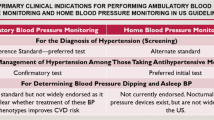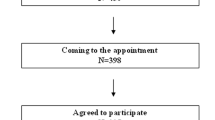Abstract
Objective: To investigate the use of ambulatory blood pressure monitoring (ABPM) in identifying and managing a group of patients referred to a tertiary centre for the assessment of their blood pressure and to illustrate the importance of introducing standardised ABPM treatment guidelines.
Patients and methods: We examined 2000 sequential ABP recordings, 1557 were first time referrals from General Practitioners, Consultants and other hospitals. All patients were referred with suspected hypertension, resistant hypertension, white coat hypertension and for investigations of secondary hypertension. Fully trained nurse specialists fitted the monitors in the hypertension clinic and recordings were performed for 24 h. The data was then analysed and stratified according to treatment guidelines and categorised according to different definitions.
Results: The group of first time referrals (n = 1557) showed an even sex distribution of 789 men and 768 women, mean age 53 ± 13.8 (12–88 years). Of this group 542 patients (35%) exhibited a white coat effect (WCE), 526 (34%) had a daytime ABP ≤139/89 mm Hg. Of these 81 (15%) had a high clinic blood pressure (ie, white coat hypertension (WCH)) according to our definition. Thirty-five of these patients were not on treatment but may have had it initiated on the basis of their clinic pressures. According to the British Hypertension Society (BHS) guidelines on clinic readings 772 (45%) of our patients would be classified as hypertensive or inadequately treated, 509 (33%) borderline and 326 (21%) as normal. Using daytime ABP levels according to O’Brien: 1031 (67%) would be defined as abnormal, 192 (12%) as borderline and 334 (21%) as normal.
Conclusion: These results illustrates how patient management may differ markedly when treating in accordance either with the BHS guidelines for clinic readings or the suggested levels for ABP. More patients had abnormal blood pressure levels according to ABPM, even though it is superior in detecting WCE and WCH. Clear guidelines for ABPM treatment levels need to be established.
This is a preview of subscription content, access via your institution
Access options
Subscribe to this journal
Receive 12 digital issues and online access to articles
$119.00 per year
only $9.92 per issue
Buy this article
- Purchase on Springer Link
- Instant access to full article PDF
Prices may be subject to local taxes which are calculated during checkout
Similar content being viewed by others
References
Purcell H, Gibbs S, Coats A, Fox K Ambulatory blood pressure monitoring and circadian variations of cardiovascular disease; clinical and research applications Int J Cardiol 1992 36 135–149
Mancia G et alBlood pressure reduction and end-organ damage in hypertension J Hypertens 1994 12 (Suppl 8) S35–S40
Verdecchia P et alWhite-coat hypertension: not guilty when correctly defined Blood Press Monit 1998 3 147–152
Coats A Reproducibility or variability of causal and ambulatory blood pressure data: implications for clinical trials J Hypertens 1990 8 (Suppl 6) S17–S20
Clark S et alAmbulatory blood pressure monitoring: validation of the accuracy and reliability of the TM 2420 according to the AAMI recommendations Hum Hypertens 1991 5 77–82
Ramsay L et alGuidelines for the management of hypertension: report of the third working party of the British Hypertension Society J Hum Hypertens 1999 13 569–592
O'Brien E et alWhat are the normal levels for ambulatory blood pressure measurement? Blood Press Monit 1998 3 131–132
Management Committee on behalf of High Blood Pressure Research Council of Australia Australian comparative outcome trial of angiotensin-converting enzyme inhibitor and diuretic-based treatment of hypertension in the elderly (ANBP2): objectives and protocol Clin Exp Pharmacol Physiol 1997 24 188–192
Chalmers J et alWHO-ISH Hypertension Guidelines Committee. 1999 World Health Organisation–International Society of Hypertension Guidelines for the Management of Hypertension J Hypertens 1999 17 151–185
O’Brien E, Staessen J Commentary What is ‘hypertension’? Lancet 1999 353 1541–1542
Author information
Authors and Affiliations
Corresponding author
Rights and permissions
About this article
Cite this article
Addison, C., Varney, S. & Coats, A. The use of ambulatory blood pressure monitoring in managing hypertension according to different treatment guidelines. J Hum Hypertens 15, 535–538 (2001). https://doi.org/10.1038/sj.jhh.1001210
Received:
Revised:
Accepted:
Published:
Issue Date:
DOI: https://doi.org/10.1038/sj.jhh.1001210
Keywords
This article is cited by
-
Review of resistant hypertension
Current Hypertension Reports (2006)
-
Self-blood-pressure monitoring—a questionnaire study: response, requirement, training, support-group popularity and recommendations
Journal of Human Hypertension (2003)



